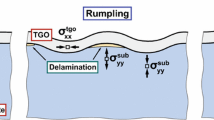Abstract
The development and relief of intrinsic growth stresses in oxide scales on nickel of different purity have been investigated by combining the deflection test in monofacial oxidation (DTMO) with acoustic-emission analysis (AE). Parallel metallographic analysis gave information about the development of the physical- defect structure and all other structural features. The investigations were performed for 100 hr at 800 as well as 900°C in air. The assumption of elastic behavior led to the best correlation between models, literature data, and results of the present investigations. Microcracks are responsible for the relief of growth stress and inward oxygen penetration leads to the typical NiO duplex scale. The growth of the microcracks is initiated at large pore populations at the oxide–metal interface that most probably form due to outward cation-diffusion and vacancy condensation. The pore formation is increased by the presence of impurities. An equilibrium of microcracking and crack healing is finally reached, leading to a continuous growth of the inner and outer NiO layers of the duplex scale. The scale growth stresses are mainly compressive and can reach maximum values of −560 MPa at 900°C. An estimation of the fracture toughness of the oxide–metal interface assuming a wavy interface led to a KIc value of about 2 MNm-3/2 at 900°C
Similar content being viewed by others
REFERENCES
M. Schütze, Oxid. Met. 44, 29 (1995).
I. Küppenbender and M. Schütze, Oxid. Met. 42, 109 (1994).
M. Schzütze, Protective Oxide Scales and Their Breakdown (Wiley, Chichester, 1997).
A.-M. Huntz and M. Schütze, Mater. High Temp. 12, 151 (1994).
J. Stringer, Corros. Sci. 10, 513 (1970).
M. Schütze, in High Temperature Corrosion and Materials Chemistry, P. Y. Hou et al., eds. (The Electrochemical Society, Pennington, NJ, 1998), p. 1.
I. Küppenbender and M. Schütze, Oxid. Met. 42, 109 (1994).
R. E. Pawel, J. V. Cathcart, and J. J. Campbell, J. Electrochem. Soc. 110, 551 (1963).
D. Delaunay, A.-M. Huntz, and P. Lacombe, Corros. Sci. 20, 1109 (1980).
J. G. Zhao and A.-M. Huntz, J. Mater. Sci. 19, 3166 (1984).
H. E. Evans, Mater. Sci. Eng. A203, 117 (1995).
W. Przybilla, Ph.D. Thesis, RWTH Aachen (2000).
T. Ueno, Trans. JIM 15, 167 (1974).
T. Ueno, Jpn. J. Appl. Phys. 14, 2081 (1975).
P. Hancock and J. R. Nicholls, Mater. Sci. Technol. 4, 398 (1988).
T. Gnäupel-Herold and W. Reimers, Proceedings of the International Conference on Residual Stresses V, T. Ericsson, M. Odin, A. Andersson, eds. Linköping, Sweden (1997).
A. Atkinson and W. Smart, J. Electrochem. Soc. 11, 2886 (1988).
M. J. Graham and R. J. Hussey, Oxid. Met. 44, 339 (1995).
F. N. Rhines and J. S. Wolf, Metall. Trans. 1, 1701 (1970).
J. Robertson and M. I. Manning, Mater. Sci. Technol. 4, 1064 (1988).
H. E. Evans, G. P. Mitchell, R. C. Lobb, and D. R. J. Owen, Proc. R. Soc. London A440, 1 (1983).
S. Mrowec, Corros. Sci. 7, 563 (1967).
G. B. Gibbs and R. Hales, Corros. Sci. 17, 487 (1977).
D. P. Moon, Oxid. Met. 31, 71 (1989).
D. P. Moon, Surf. Interface Anal. 12, 27 (1988).
G. C. Stoney, Proc. R. Soc. London A82, 172 (1909).
A. Brenner and S. Senderoff, J. Res. Nat. Bur. Std. 42, 105 (1949).
M. Schulte, Ph.D. Thesis, RWTH Aachen (1996).
F. Morin, L. C. Dufour, and G. Trudel, Oxid. Met. 37, 39 (1992).
F. Morin and L. C. Dufour, Oxid. Met. 39, 137 (1993).
P. Kofstad, Oxid. Met. 24, 265 (1985).
A. G. Evans, D. Rajder, and D. L. Douglass, Oxid. Met. 4, 151 (1972).
Author information
Authors and Affiliations
Rights and permissions
About this article
Cite this article
Przybilla, W., Schütze, M. Role of Growth Stresses on the Structure of Oxide Scales on Nickel at 800 and 900°C. Oxidation of Metals 58, 103–145 (2002). https://doi.org/10.1023/A:1016016608591
Issue Date:
DOI: https://doi.org/10.1023/A:1016016608591




